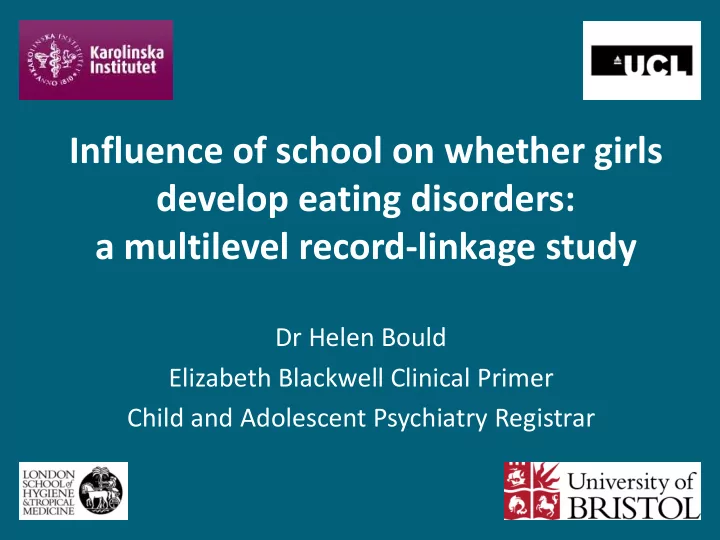

Influence of school on whether girls develop eating disorders: a multilevel record-linkage study Dr Helen Bould Elizabeth Blackwell Clinical Primer Child and Adolescent Psychiatry Registrar
Eating Disorders Up to 6% of adolescent girls (Smink 2014) SMR: 5.9 (95% CI 4.2-8.3) for anorexia nervosa (Arcelus, 2011)
School Clustering Clinical impression Weight loss behaviours vary (Austin, 2013) More underweight girls More losing weight (Mueller, 2010) School level interventions?
Variation in Rates between Schools Composition: characteristics of the students
Parental Education Goodman, 2014
Variation in Rates between Schools Context: characteristics of the school
Stockholm Youth Cohort • Record linkage study • 0 – 17 year olds • In Stockholm County 2001-2011 • N=735,096
Sources of diagnosis • Throughout: Sweden Inpatient (SOSSLV) • From 1993: Stockholm Inpatient (VALSLV) • From 1995: Adult psychiatry (PVS) • From 1997: Sweden Daytime surgery (SOSDAG) • From 1998: Stockholm Outpatient (VALOVR) • From 2001: CAMHS diagnosis/reason for visit (BUPDIA/BUPKO) • From 2005: Primary care (VALKON) • From 2007: Private (VALARV)
Inclusion Criteria - Subset of SYC who left Gymnasium 2001-2010 - At a school with >10 pupils - Had a final exam result - No previous eating disorder diagnosis - Born in Sweden - Female
Outcome • Eating Disorder (ED) aged 16-20 • Any diagnosis (IP/OP/any eating disorder) • Attendance at a specialist eating disorder clinic (Ahren, 2013)
School Variables • Built from 142,832 subjects (boys & girls) • To calculate for each school - proportion of girls - proportion of parents with higher education - proportion of students/parents born abroad - proportion with high disposable income
Descriptive Data • 55,059 girls attending 409 Gymnasiums • 2.37% diagnosed with an ED aged 16-20
School Variables Variables Mean (range) in schools (%) Number of Students per School 1513 (10-3956) Eating Disorder in girls aged 16-20 2.42 (1.3-16.7) Female 55.04 (1.6-100) Final exam score in the top 20% 23.16 (0-94.7) Disposable income in the top 20% for Sweden 32.45 (0-70.60) One or both parents with higher education 57.16 (12.73-91.67) Mother with higher education 37.48 (0-73.34) One or both parents born outside Sweden 25.54 (0-67.37) Child born abroad 6.24 (0-40)
Proportion of Variance at School Level Unadjusted and Adjusted Models % of unexplained variance at school level (95% CI) Unadjusted Model Whole sample (N=62,990) 4.3 (2.7 to 6.7) Complete Case sample (N=55,059) 4.4 (2.8 to 7.1) Adjusted for Multiple Individual Level Variables Parental level of education, psychiatric history in either 2.9 (1.6 to 5.3) parent, maternal age, disposable income, either parent born outside Sweden
Odds Ratio for eating disorder diagnosis for a 10% increase in school variables OR for Incidence of Eating Disorder 1.3 1.2 1.1 1 0.9 0.8 0.7 0.6 % Female % Born outside % Final exam % Disposable % One or both % One or both Sweden score in top income in top parents with parents born quintile quintile post-school outside Sweden education* 10% Increase in School Level Variables School Level Variable only Adjusted for Individual Variables Adjusted for proportion of parents with higher education
% of parents with higher education Adjusted for a 10% increase in students in the Odds Ratio for Eating Disorder diagnosis (95% CI, p value)* school with the following characteristics for a 10% increase in the proportion of parents with higher education Adjusted for Individual Variables only* 1.14 (1.09 to 1.19), p<0.0001 Female 1.14 (1.09 to 1.18), p<0.0001 Born outside Sweden 1.13 (1.08 to 1.18), p<0.0001 Final exam score in the top 20% 1.13 (1.05 to 1.21), p=0.001 Disposable income in the top 20% 1.12 (1.04 to 1.20), p=0.002 One or both parents born outside Sweden 1.14 (1.09 to 1.19), p<0.0001 * Parental level of education, psychiatric history in either parent, maternal age, disposable income, either parent born outside Sweden
Cross Level Interaction • Individual and school level parental education • No evidence of cross-level interaction
Possible mechanisms ED are contagious Some school cultures encourage ED Some schools are better at identifying ED
ED are contagious (cognitive/perceptual) Rates of body dissatisfaction are higher in areas of lower average BMI (McLaren, 2003) In schools with more underweight girls, individuals are more likely to be trying to lose weight (Mueller, 2010) Body size perceived to be most normal can be altered with visual adaptation (Winkler, 2005; Glauert, 2009) So can perception of own size (Bould, unpublished)
ED are contagious (behavioural) Adolescent girls’ extreme weight loss behaviours are associated with those in their friendship groups (Paxton 1999, Hutchinson 2007)
School culture may encourage ED A school salad bar increases the amount of fruit & veg purchased by students (Slusser, 2007)
School culture may encourage ED Girls in single sex (vs mixed) schools associate intelligence and professional success with being thinner (Tiggemann, 2001)
Possible mechanisms • Some schools may be better at identifying ED Outcome: Any referral to Child and Adolescent Mental Health Services 10% increase in proportion of parents with higher education: OR 1.00 (95% CI 0.98, 1.05), p = 0.739)
Implications Higher risk in all girls’ public schools Developing school level interventions Increasing awareness in at risk schools
Future Directions • Eating Disorders & Body Dissatisfaction in ALSPAC • GHQ, BMI, alcohol use, smoking, other mental illnesses in Swedish Cohorts
Acknowledgements Cecilia Magnusson Christina Dalman Henrik Dal Glyn Lewis Nadia Micali Bianca DeStavola Jonathan Evans
Any questions?
Recommend
More recommend